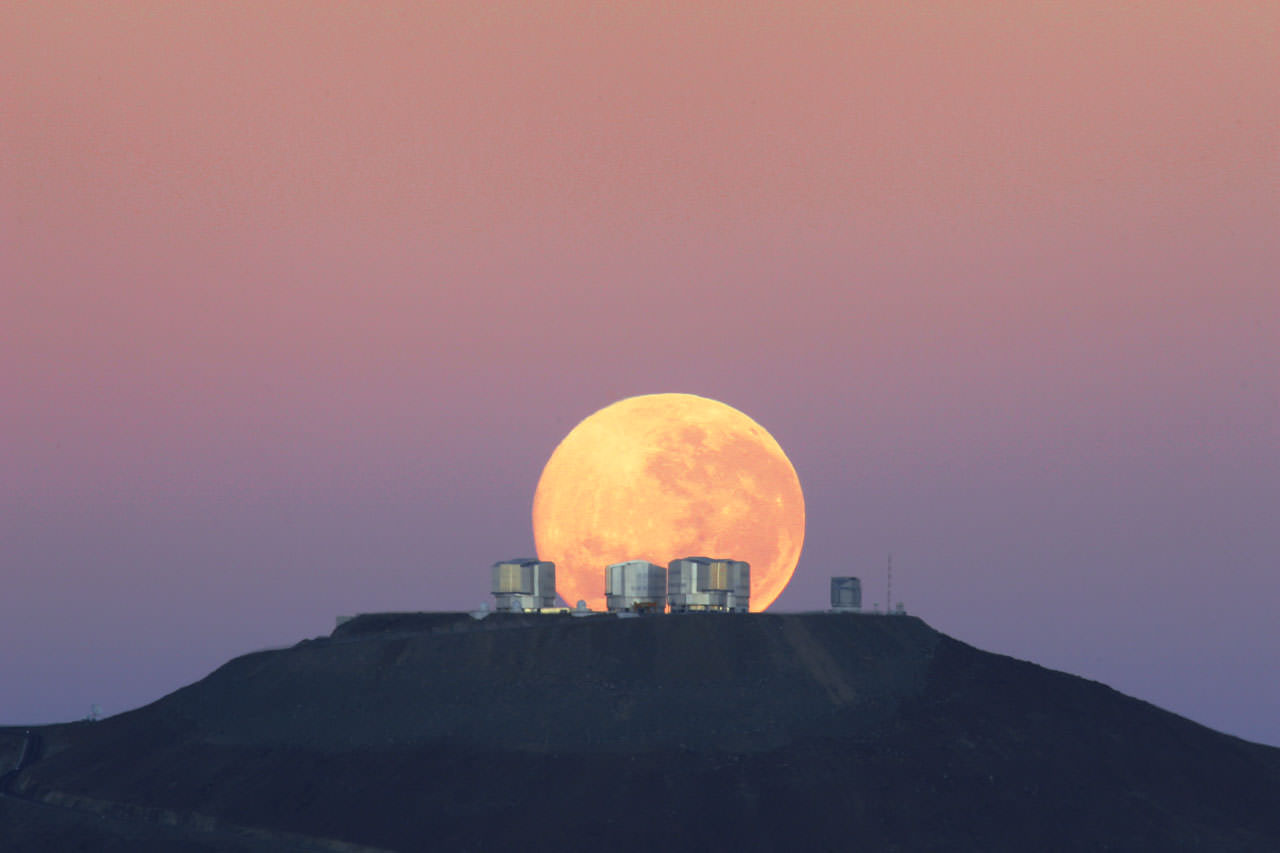[/caption]
Need a new desktop image? Usually the Very Large Telescope on Cerro Paranal in Chile provides us with stunning views of the cosmos. This image, however, is a gorgeous view of the observatory itself. As the Moon was setting after a long night of observing, ESO staff member Gordon Gillet welcomed the new day by capturing this stunning image from 14 km away. This image is not a montage or computer-generated (such as the infamous ‘Moon and Sun over the North Pole‘ urban legend)
The ESO website explains:
The Moon appears large because it is seen close to the horizon and our perception is deceived by the proximity of references on the ground. In order to get this spectacular close view, a 500-mm lens was necessary. The very long focal length reduces the depth of field making the objects in focus appear as if they were at the same distance. This effect, combined with the extraordinary quality of this picture, gives the impression that the Moon lies on the VLT platform, just behind the telescopes, even though it is in fact about 30,000 times further away.
Interestingly, Gillet took the image from the road leading to the nearby Cerro Armazones, the peak recently chosen by the ESO Council as the preferred location for the planned 42-meter European Extremely Large Telescope (E-ELT), which should be open for business by 2018.
Source: ESO


Note that no Moon Effect was damaged during the production of this film, as BA points out after just have been through that old topic _once again_. (Like the Moon, it expands at is gets closer to the horizon.)
1) This picture is rather old. Someone on BA said it’s from 2004, and I remember that it was once used as a “Merry Christmas” message from ESO, but I don’t remember when that was exactly (a few years ago…).
2) Cerro Amazones? Wait, I know that mountain, although I haven’t visited it myself, a colleague of mine did. He works at the “Astronomisches Institut der Ruhr-Universität Bochum” ( http://www.astro.ruhr-uni-bochum.de/ ) and this institute of my university has an operating facility right on that hill – a small telescope, which will look even cuter in front of its new neighbor, but nonetheless! See the link for details!
Sorry, for the double post, but to make things easier, here is the direct link to the observatory:
http://www.astro.ruhr-uni-bochum.de/astro/oca/index.html
As the ESO website explains — “… 500-mm lens … very long focal length … making the objects in focus appear as if …” –, you would not see this with your naked eyes. The “real” moon never appears so big, and — I checked it — the moon is not bigger when it’s near the horizon. A picture is worth a thousand lies.
Dr Flimmer,
It’s interesting to compare the setup and amenities at the AIRUB facility on Cerro Amazones with the new remotely operated TRAPPIST scope on La Silla (they both have similar sized scopes). The AIRUB website had this interesting note:
“An – incomplete – list of things you should bring along:
* sleeping bag and bedcovers
(Night time temperatures are known to be well below 0 ° C/30 ° F)
* towels
* flashlight
* plug / voltage adapter (see wikipedia)
* skin / lip moisturizer
* sun sun screener and has
* sturdy shoes”
I’ve had the chance to use a few observatory facilities in the northern hemisphere but can’t recall any of them recommending packing a sleeping bag! (Although I’ll admit to using a sleeping bag out in the elements when time and sky conditions permitted 🙂 ).